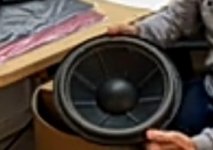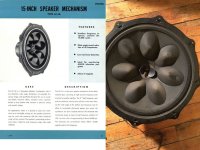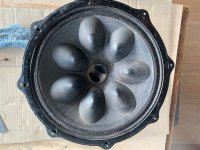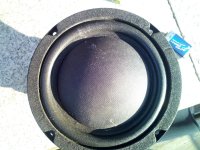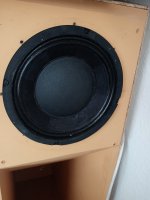kurt mueller one of the leaders in production gives a nice overview what they do today
http://wp13470711.server-he.de/membranen/
http://wp13470711.server-he.de/membranen/
Attachments
cone stiffening technique by glueing T shape elements on the cone one or two sided.
Klaus Reck from Reckhorn sold a driver made like this
but Tannoy does a more radical stiffening of their big paper cones on the backside of the cone glueing triangle shaped (!) craft paper on it.
Saw it on hifi fairs.
Klaus Reck from Reckhorn sold a driver made like this
but Tannoy does a more radical stiffening of their big paper cones on the backside of the cone glueing triangle shaped (!) craft paper on it.
Saw it on hifi fairs.
Attachments
Here is the proof of what I saw on a hifi fair.
Tannoy Westminster with some effective cone stiffening!
https://reconingspeakers.com/tannoy-westminster-3839-surround-conversion/
As a demonstration I show how a triangle is formed and with some elastic glue like silicone sealant it could be fixed to the cone.
Tannoy Westminster with some effective cone stiffening!
https://reconingspeakers.com/tannoy-westminster-3839-surround-conversion/
As a demonstration I show how a triangle is formed and with some elastic glue like silicone sealant it could be fixed to the cone.
Attachments
-
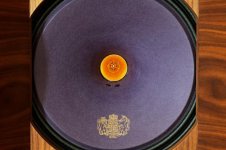 unnamed.jpg31.4 KB · Views: 51
unnamed.jpg31.4 KB · Views: 51 -
 Tannoy-Westminster-3839-Surround-Conversion-2-768x576.jpg66.3 KB · Views: 63
Tannoy-Westminster-3839-Surround-Conversion-2-768x576.jpg66.3 KB · Views: 63 -
 Tannoy-Westminster-3839-Surround-Conversion-7-768x576.jpg63.4 KB · Views: 52
Tannoy-Westminster-3839-Surround-Conversion-7-768x576.jpg63.4 KB · Views: 52 -
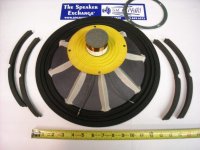 Tannoy-Westminster-3839-Surround-Conversion-5-768x576.jpg61.4 KB · Views: 52
Tannoy-Westminster-3839-Surround-Conversion-5-768x576.jpg61.4 KB · Views: 52 -
Tannoy Westminster 3839 Surround Conversion - The Speaker Exchan.pdf1.5 MB · Views: 68
-
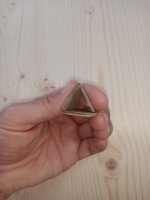 IMG_20250325_172135.jpg197.9 KB · Views: 52
IMG_20250325_172135.jpg197.9 KB · Views: 52
Last edited:
Seems like tannoy shaped correctly a turned over "V" from craft paper and glue it to the backside of their big cones
I think that this deserves more interest, the main cone takes all the forces from the coil, the air pressure inside the cabinet, and the surround; the dust cap is edge driven, surely this would help greatly in pistonic motion? There would be no sound reflections, or air pressure on the reverse side, and it would have smooth, even dispersion. Perhaps it would work well on a 3 inch driver, used as the wide band in a WAW speaker.more orthodox diy cone stiffening using
a big dustcap
on a 15cm driver
View attachment 1437349
View attachment 1437348
the subwoofer inside the box is with 1cm concrete and only 3mm wood panels just offering the form for it
View attachment 1437350
If the dome dust cap was paper, would it be worth painting it with PVA ?
I think this idea could be further improved by a filler between the cone and dust cap.
@cracked case
I heard the critique that the big dustcap is not supported in the middle where the voice coil has its greatest stiffness.
For the moment I have no measurement data on this at hand for posting but usually you get with this tweak (glueing a big dustcap in) a linear response up to a massive break up point typical for hard cone drivers. So it seems to do something desired for subwoofer use.
From this driver (GDN75) which was measured in a german diy hifi magazine many years ago where I learned or recognized for the first time about this cone stiffening technique that it follows the same response in frequency:
linear up to a high resonance break up point and then a pretty perfect 12db decline following the theory of how a hard cone should fall off after break up.
This is legendary Radiotehnika RRR GDN75 from Lettland (former russian production line)

it was used in the S90B loudspeaker

I heard the critique that the big dustcap is not supported in the middle where the voice coil has its greatest stiffness.
For the moment I have no measurement data on this at hand for posting but usually you get with this tweak (glueing a big dustcap in) a linear response up to a massive break up point typical for hard cone drivers. So it seems to do something desired for subwoofer use.
From this driver (GDN75) which was measured in a german diy hifi magazine many years ago where I learned or recognized for the first time about this cone stiffening technique that it follows the same response in frequency:
linear up to a high resonance break up point and then a pretty perfect 12db decline following the theory of how a hard cone should fall off after break up.
This is legendary Radiotehnika RRR GDN75 from Lettland (former russian production line)
it was used in the S90B loudspeaker
Last edited:
As if it was not enough I know that the paper of the GDN75 is very stiff due to chemical treating (I think something like "Wasserglas" - aquaplas). Something you can only see looking on the back side of the cone.
I once had a home hifi system with twelve of these drivers in closed box system EQed to down to 35 hz.
I found the measurements of Klang und Ton from 1994 where the Radiotehnika driver was measured

I have the magazine 1994 nr 3 on my laptop and could look for it ;-)
I once had a home hifi system with twelve of these drivers in closed box system EQed to down to 35 hz.
I found the measurements of Klang und Ton from 1994 where the Radiotehnika driver was measured
I have the magazine 1994 nr 3 on my laptop and could look for it ;-)
The big dustcap tweak I did sometimes for "only subwoofer use" drivers:
and here on a 20cm driver (its difficult to get bigger dustcaps)
I really appreciate the use of beryllium for TAD high frequency drivers.
What i wonder is why they just use simple paper diaphragms for the bass drivers.
As far as I know paper has not enough stiffness for a really good sound reproduction - especially big drivers suffer from bending forces in the diaphragm.
If they would have very big dustcaps this would bring lots of stability like with a 13cm paper diaphragm bass driver I tweaked with a big paper dustcap for getting true piston motion.
What i wonder is why they just use simple paper diaphragms for the bass drivers.
As far as I know paper has not enough stiffness for a really good sound reproduction - especially big drivers suffer from bending forces in the diaphragm.
If they would have very big dustcaps this would bring lots of stability like with a 13cm paper diaphragm bass driver I tweaked with a big paper dustcap for getting true piston motion.
and here on a 20cm driver (its difficult to get bigger dustcaps)
Thin wire for the fullrange drivers helps bringing distortion further down. This is quite audible. Four meters 0.09mm2 cable. It's not even copper. Maybe aluminium wire.

Some Fotos with better light.

Some Fotos with better light.
Attachments
I did wonder if a paper or cardboard tube (or balsa wood) could bridge the gap between the voice coil former and the dust cap, but I'm not sure if that would cause more problems. I wonder if a reverse cone, instead of a dome would work, but that would mean making one.I heard the critique that the big dustcap is not supported in the middle where the voice coil has its greatest stiffness.
@cracked case
concerning: filling the space between original cone and added big dustcap
could be done with polyurethan foam but I fear two things:
the cone construction would become heavy, maybe too heavy if not having a driver with oversized magnet
how can I guarantee the even dispersion of foam below the big dustcap on a first try with an existing driver?
Its nearly impossible to get a clean work and to get a fill without having foam leaking out or leaving parts hollow
pu foam is a nasty stuff expanding and ruining everything in an uncontrollable manner
concerning: filling the space between original cone and added big dustcap
could be done with polyurethan foam but I fear two things:
the cone construction would become heavy, maybe too heavy if not having a driver with oversized magnet
how can I guarantee the even dispersion of foam below the big dustcap on a first try with an existing driver?
Its nearly impossible to get a clean work and to get a fill without having foam leaking out or leaving parts hollow
pu foam is a nasty stuff expanding and ruining everything in an uncontrollable manner
Götz Schwamkrug mentioned in one of his books on loudspeakers that glueing in flat sheets of polystyrol onto the cone can stiffen out a cone with several layers if necessary.
Here is his first book on loudspeakers mentioning the aluminium foil from which I learned in the 90ies about aluminium sandwich cones
http://www.hornlautsprecher.de/download_dichtung.htm
click on the book, download 35mb
Here is his first book on loudspeakers mentioning the aluminium foil from which I learned in the 90ies about aluminium sandwich cones
http://www.hornlautsprecher.de/download_dichtung.htm
click on the book, download 35mb
I wondered about using PVA soaked tissue paper, screwed up and compressed between the dust cap and cone, when the PVA hardens, it would form a rigid "lattice" between them. What would be perfect, would be a soft foam, that would harden in time, so it could be cut to shape, compressed between them whilst the dust cap glue sets. For a bass driver, the disspersion is unimportant, so the dust cap could be inverted, so there's be very little space to fill. This would also work if you wanted a directional speaker that "beams".
good idea, soaked tissue could work.
There are many variants possible.
From just putting a fluffy tissue soaked with diluted pva glue as a single stiffening layer onto the surface of the cone up to to having a kind of filling below the big added dustcap for supporting the structure like using scrambled paper wetted with glue.
The aluminium foil trick works great for fullrange drivers.
I use the big dustcap method as a quick alternative to putting aluminium foil to the cone what I practice usually.
For pure subwoofer use the dustcap trick is sparing working time.
There are many variants possible.
From just putting a fluffy tissue soaked with diluted pva glue as a single stiffening layer onto the surface of the cone up to to having a kind of filling below the big added dustcap for supporting the structure like using scrambled paper wetted with glue.
The aluminium foil trick works great for fullrange drivers.
I use the big dustcap method as a quick alternative to putting aluminium foil to the cone what I practice usually.
For pure subwoofer use the dustcap trick is sparing working time.
- Home
- Design & Build
- Construction Tips
- DIY stiffening cone techniques - How to
